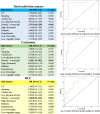A registration trend in eyelid skin cancers and associated risk factors in Iran, 2005-2016
- PMID: 37777736
- PMCID: PMC10543867
- DOI: 10.1186/s12885-023-11414-z
A registration trend in eyelid skin cancers and associated risk factors in Iran, 2005-2016
Abstract
Background: Eyelid skin cancers are the most prevalent ophthalmic malignancies. This study aimed to evaluate the association of the Human Development Index (HDI) and lifestyle risk factors with eyelid skin cancers in Iran.
Methods: This ecological study analyzed the data collected from the Iranian National Population-based Cancer Registry (2005-2016). The data on provincial-level eyelid skin cancer risk factors were obtained from national sources. The association between provincial HDI and lifestyle risk factors with the prevalence of eyelid skin cancers was assessed.
Results: The mean 12-year age-standardized incidence rate (ASIR) of eyelid skin cancers was 16.22 per 100,000 (9,104 cases). The overall ASIR showed an upward trend with an estimated annual average increase of 0.006 per year. There were positive correlations between the prevalence of overall eyelid skin cancers and provincial HDI, smoking, and obesity (r = 0.32, 0.42, and 0.37, respectively). In multivariate analysis, obesity/overweight remained a positive predictor for high prevalence of total eyelid skin cancers (OR = 1.97, 95%CI = 1.08-3.58, P = 0.026), carcinoma (2.10, 1.15-3.83, P = 0.015), and basal cell carcinoma (1.48, 0.99-2.20, P = 0.054).
Conclusions: An increasing trend in ASIR of eyelid skin cancers was observed in more than a decade in Iran which was positively associated with provincial HDI and prevalence of obesity. The findings of the study highlight the importance of promotional programs for preventing obesity/overweight and appropriate allocation of screening facilities based on the HDI level.
Keywords: Age-standardized incidence rates; Eyelid skin cancers; Iran; Risk factors.
© 2023. BioMed Central Ltd., part of Springer Nature.
Conflict of interest statement
The authors have no conflicts of interest to declare relevant to this article's contents.
Figures




Similar articles
-
Incidence of eyelid cancers in Taiwan: a 21-year review.Ophthalmology. 2006 Nov;113(11):2101-7. doi: 10.1016/j.ophtha.2006.06.001. Epub 2006 Sep 7. Ophthalmology. 2006. PMID: 16962174
-
[Non-melanotic Tumors of the Eyelids Skin and Inner Corner - Basocellular Carcinoma].Cesk Slov Oftalmol. 2015 Winter;71(6):293-301. Cesk Slov Oftalmol. 2015. PMID: 26782918 Czech.
-
Nationwide Trends in the Incidence and Survival of Eyelid Skin Cancers in Korea.Ophthalmic Epidemiol. 2020 Dec;27(6):438-448. doi: 10.1080/09286586.2020.1767152. Epub 2020 Jun 2. Ophthalmic Epidemiol. 2020. PMID: 32486892
-
Basal cell carcinoma of the eyelid and periocular skin.Surv Ophthalmol. 1993 Sep-Oct;38(2):169-92. doi: 10.1016/0039-6257(93)90100-l. Surv Ophthalmol. 1993. PMID: 8235999 Review.
-
Basal cell carcinomas of the eyelids.Ophthalmologica. 2005 Mar-Apr;219(2):57-71. doi: 10.1159/000083263. Ophthalmologica. 2005. PMID: 15802929 Review.
References
MeSH terms
LinkOut - more resources
Full Text Sources
Medical

